2009 CHEVROLET CORVETTE maintenance
[x] Cancel search: maintenancePage 192 of 434

BUCKLE PASSENGER
This message reminds you to buckle the passenger’s
safety belt.
This message displays and a sound will be heard when
the ignition is on, the driver’s safety belt is buckled, the
passenger’s safety belt is unbuckled with the passenger
airbag enabled, and the vehicle is in motion. You should
have the passenger buckle their safety belt.
The reminder will be repeated if the ignition is on, the
vehicle is in motion, the driver is buckled and the
passenger is still unbuckled, and the passenger airbag
is enabled. If the passenger’s safety belt is already
buckled, this message will not come on.
BUCKLE SEATBELT
This message reminds you to buckle the driver’s
safety belt.
This message displays and a sound will be heard when
the ignition is on, the driver’s safety belt is unbuckled,
and the vehicle is in motion. You should buckle your
safety belt.
If the driver remains unbuckled when the ignition is on
and the vehicle is in motion, the reminder will be
repeated. If the driver’s safety belt is already buckled,
this message will not come on.This message is an additional reminder to the safety
belt reminder light in the instrument panel cluster.
SeeSafety Belt Reminders on page 3-34for more
information.
CHANGE BRAKE PADS
On vehicles with electronic brake pad wear sensors,
this message will be displayed when the pads are worn.
See your dealer/retailer for service.
CHANGE ENGINE OIL
This message displays when the life of the engine oil
has expired. SeeScheduled Maintenance on page 6-4.
After an oil change, the engine oil life system must
be reset. See “Engine Oil Life” underDIC Operation
and Displays on page 3-49. Also, seeEngine Oil
on page 5-20andEngine Oil Life System on page 5-26
for more information.
CHECK BRAKE FLUID
This message displays, a sound will be heard, and the
brake system warning light on the instrument panel
cluster turns on if the ignition is on to inform the driver
that the brake �uid level is low. SeeBrake System
Warning Light on page 3-38. Have the brake system
serviced by your dealer/retailer as soon as possible.
SeeBrakes on page 5-44.
3-56
Page 244 of 434
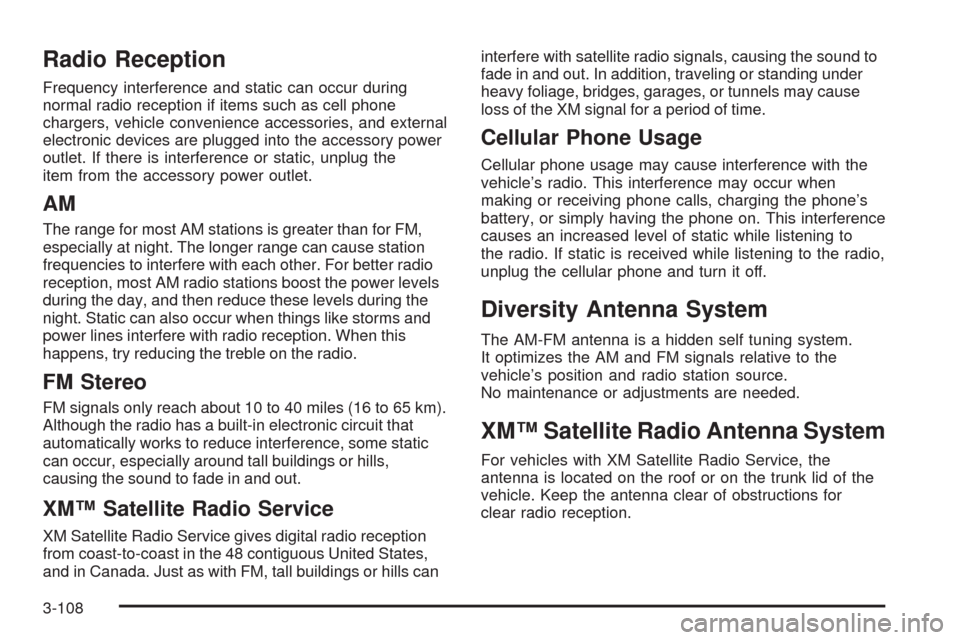
Radio Reception
Frequency interference and static can occur during
normal radio reception if items such as cell phone
chargers, vehicle convenience accessories, and external
electronic devices are plugged into the accessory power
outlet. If there is interference or static, unplug the
item from the accessory power outlet.
AM
The range for most AM stations is greater than for FM,
especially at night. The longer range can cause station
frequencies to interfere with each other. For better radio
reception, most AM radio stations boost the power levels
during the day, and then reduce these levels during the
night. Static can also occur when things like storms and
power lines interfere with radio reception. When this
happens, try reducing the treble on the radio.
FM Stereo
FM signals only reach about 10 to 40 miles (16 to 65 km).
Although the radio has a built-in electronic circuit that
automatically works to reduce interference, some static
can occur, especially around tall buildings or hills,
causing the sound to fade in and out.
XM™ Satellite Radio Service
XM Satellite Radio Service gives digital radio reception
from coast-to-coast in the 48 contiguous United States,
and in Canada. Just as with FM, tall buildings or hills caninterfere with satellite radio signals, causing the sound to
fade in and out. In addition, traveling or standing under
heavy foliage, bridges, garages, or tunnels may cause
loss of the XM signal for a period of time.
Cellular Phone Usage
Cellular phone usage may cause interference with the
vehicle’s radio. This interference may occur when
making or receiving phone calls, charging the phone’s
battery, or simply having the phone on. This interference
causes an increased level of static while listening to
the radio. If static is received while listening to the radio,
unplug the cellular phone and turn it off.
Diversity Antenna System
The AM-FM antenna is a hidden self tuning system.
It optimizes the AM and FM signals relative to the
vehicle’s position and radio station source.
No maintenance or adjustments are needed.
XM™ Satellite Radio Antenna System
For vehicles with XM Satellite Radio Service, the
antenna is located on the roof or on the trunk lid of the
vehicle. Keep the antenna clear of obstructions for
clear radio reception.
3-108
Page 246 of 434

Your Driving, the Road, and
the Vehicle
Driving for Better Fuel Economy
Driving habits can affect fuel mileage. Here are some
driving tips to get the best fuel economy possible.
Avoid fast starts and accelerate smoothly.
Brake gradually and avoid abrupt stops.
Avoid idling the engine for long periods of time.
When road and weather conditions are appropriate,
use cruise control, if equipped.
Always follow posted speed limits or drive more
slowly when conditions require.
Keep vehicle tires properly in�ated.
Combine several trips into a single trip.
Replace the vehicle’s tires with the same TPC Spec
number molded into the tire’s sidewall near the size.
Follow recommended scheduled maintenance.
Defensive Driving
Defensive driving means “always expect the
unexpected.” The �rst step in driving defensively is to
wear your safety belt — SeeSafety Belts: They Are for
Everyone on page 1-8.
{CAUTION:
Assume that other road users (pedestrians,
bicyclists, and other drivers) are going to be
careless and make mistakes. Anticipate what they
might do and be ready. In addition:
Allow enough following distance between you
and the driver in front of you.
Focus on the task of driving.
Driver distraction can cause collisions resulting in
injury or possible death. These simple defensive
driving techniques could save your life.
4-2
Page 259 of 434
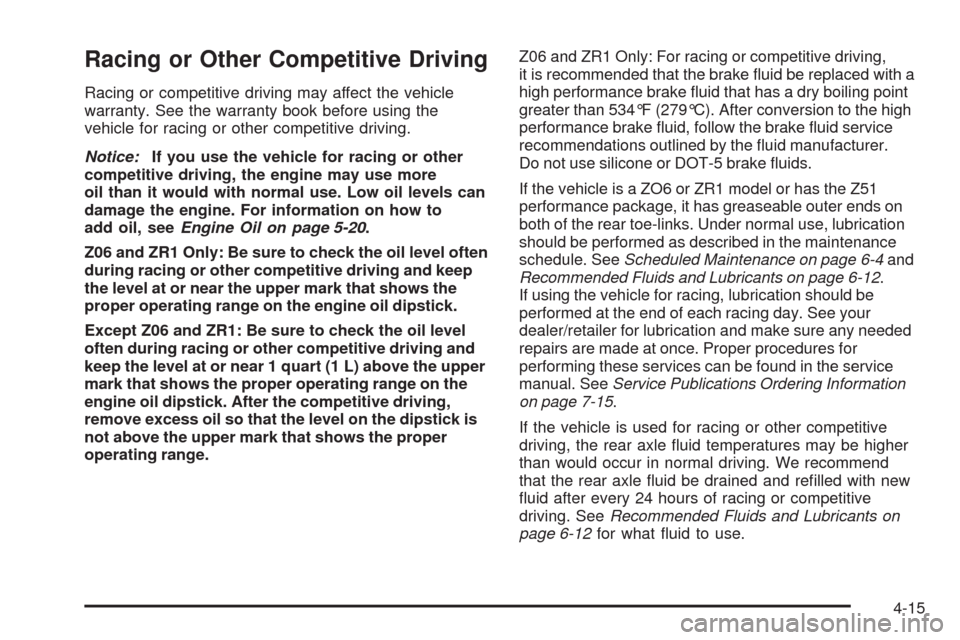
Racing or Other Competitive Driving
Racing or competitive driving may affect the vehicle
warranty. See the warranty book before using the
vehicle for racing or other competitive driving.
Notice:If you use the vehicle for racing or other
competitive driving, the engine may use more
oil than it would with normal use. Low oil levels can
damage the engine. For information on how to
add oil, seeEngine Oil on page 5-20.
Z06 and ZR1 Only: Be sure to check the oil level often
during racing or other competitive driving and keep
the level at or near the upper mark that shows the
proper operating range on the engine oil dipstick.
Except Z06 and ZR1: Be sure to check the oil level
often during racing or other competitive driving and
keep the level at or near 1 quart (1 L) above the upper
mark that shows the proper operating range on the
engine oil dipstick. After the competitive driving,
remove excess oil so that the level on the dipstick is
not above the upper mark that shows the proper
operating range.Z06 and ZR1 Only: For racing or competitive driving,
it is recommended that the brake �uid be replaced with a
high performance brake �uid that has a dry boiling point
greater than 534°F (279°C). After conversion to the high
performance brake �uid, follow the brake �uid service
recommendations outlined by the �uid manufacturer.
Do not use silicone or DOT-5 brake �uids.
If the vehicle is a ZO6 or ZR1 model or has the Z51
performance package, it has greaseable outer ends on
both of the rear toe-links. Under normal use, lubrication
should be performed as described in the maintenance
schedule. SeeScheduled Maintenance on page 6-4and
Recommended Fluids and Lubricants on page 6-12.
If using the vehicle for racing, lubrication should be
performed at the end of each racing day. See your
dealer/retailer for lubrication and make sure any needed
repairs are made at once. Proper procedures for
performing these services can be found in the service
manual. SeeService Publications Ordering Information
on page 7-15.
If the vehicle is used for racing or other competitive
driving, the rear axle �uid temperatures may be higher
than would occur in normal driving. We recommend
that the rear axle �uid be drained and re�lled with new
�uid after every 24 hours of racing or competitive
driving. SeeRecommended Fluids and Lubricants on
page 6-12for what �uid to use.
4-15
Page 274 of 434

In�ation - Tire Pressure.................................5-70
High-Speed Operation...................................5-72
Tire Pressure Monitor System.........................5-73
Tire Pressure Monitor Operation.....................5-74
Tire Inspection and Rotation...........................5-76
When It Is Time for New Tires.......................5-77
Buying New Tires.........................................5-78
Different Size Tires and Wheels......................5-79
Uniform Tire Quality Grading..........................5-80
Wheel Alignment and Tire Balance..................5-82
Wheel Replacement......................................5-82
Tire Chains..................................................5-85
Lifting the Vehicle.........................................5-86
If a Tire Goes Flat........................................5-90
Appearance Care............................................5-91
Interior Cleaning...........................................5-91
Fabric/Carpet...............................................5-93
Coated Moldings...........................................5-93
Leather.......................................................5-94
Instrument Panel, Vinyl, and Other
Plastic Surfaces........................................5-94
Cargo Cover and Convenience Net.................5-95
Care of Safety Belts......................................5-95
Weatherstrips...............................................5-95Washing Your Vehicle...................................5-95
Cleaning Exterior Lamps/Lenses.....................5-96
Finish Care..................................................5-96
Windshield and Wiper Blades.........................5-97
Removable Roof Panel..................................5-98
Convertible Top............................................5-98
Aluminum or Chrome-Plated Wheels and Trim . . .5-99
Tires...........................................................5-99
Finish Damage...........................................5-100
Underbody Maintenance...............................5-100
Fiberglass Springs (Composite Springs)..........5-100
Chemical Paint Spotting
...............................5-100
Vehicle Identi�cation.....................................5-101
Vehicle Identi�cation Number (VIN)................5-101
Service Parts Identi�cation Label...................5-101
Electrical System..........................................5-102
Add-On Electrical Equipment.........................5-102
Headlamp Wiring........................................5-102
Windshield Wiper Fuses...............................5-102
Power Windows and Other Power Options......5-102
Fuses and Circuit Breakers..........................5-103
Instrument Panel Fuse Block........................5-103
Engine Compartment Fuse Block...................5-106
Capacities and Speci�cations........................5-110
Section 5 Service and Appearance Care
5-2
Page 277 of 434
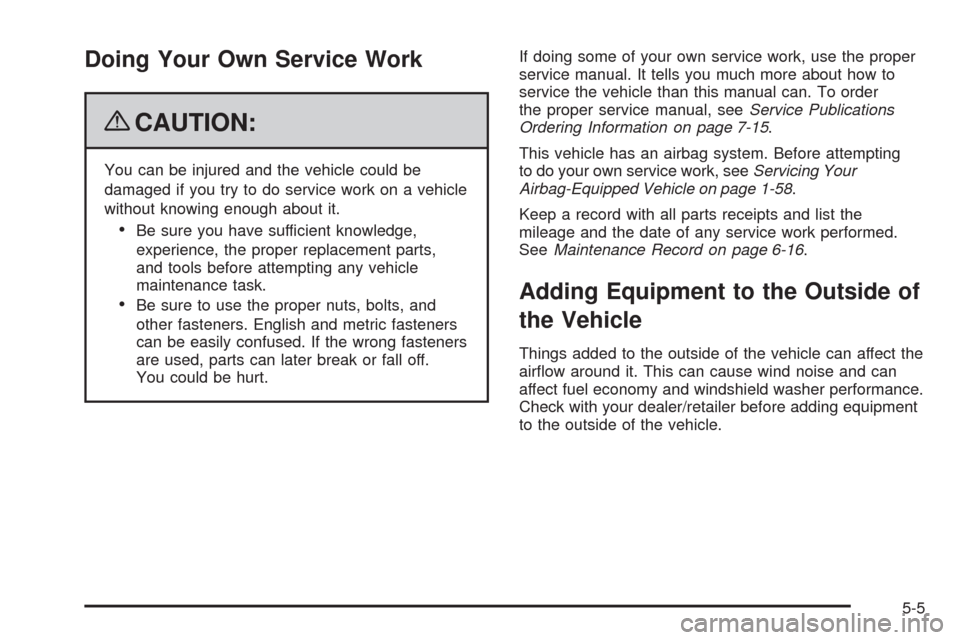
Doing Your Own Service Work
{CAUTION:
You can be injured and the vehicle could be
damaged if you try to do service work on a vehicle
without knowing enough about it.
Be sure you have sufficient knowledge,
experience, the proper replacement parts,
and tools before attempting any vehicle
maintenance task.
Be sure to use the proper nuts, bolts, and
other fasteners. English and metric fasteners
can be easily confused. If the wrong fasteners
are used, parts can later break or fall off.
You could be hurt.If doing some of your own service work, use the proper
service manual. It tells you much more about how to
service the vehicle than this manual can. To order
the proper service manual, seeService Publications
Ordering Information on page 7-15.
This vehicle has an airbag system. Before attempting
to do your own service work, seeServicing Your
Airbag-Equipped Vehicle on page 1-58.
Keep a record with all parts receipts and list the
mileage and the date of any service work performed.
SeeMaintenance Record on page 6-16.Adding Equipment to the Outside of
the Vehicle
Things added to the outside of the vehicle can affect the
air�ow around it. This can cause wind noise and can
affect fuel economy and windshield washer performance.
Check with your dealer/retailer before adding equipment
to the outside of the vehicle.
5-5
Page 278 of 434
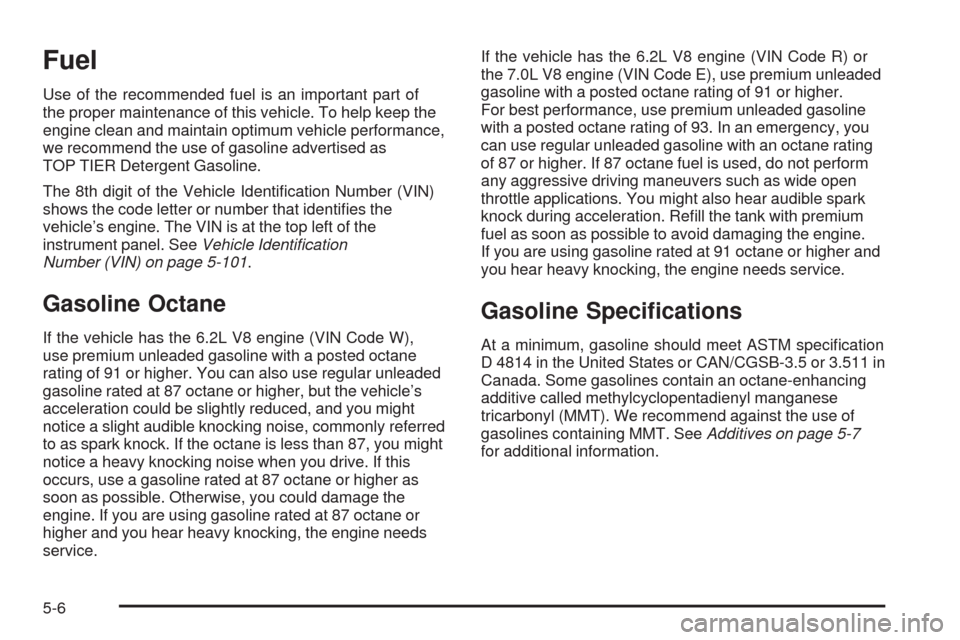
Fuel
Use of the recommended fuel is an important part of
the proper maintenance of this vehicle. To help keep the
engine clean and maintain optimum vehicle performance,
we recommend the use of gasoline advertised as
TOP TIER Detergent Gasoline.
The 8th digit of the Vehicle Identi�cation Number (VIN)
shows the code letter or number that identi�es the
vehicle’s engine. The VIN is at the top left of the
instrument panel. SeeVehicle Identification
Number (VIN) on page 5-101.
Gasoline Octane
If the vehicle has the 6.2L V8 engine (VIN Code W),
use premium unleaded gasoline with a posted octane
rating of 91 or higher. You can also use regular unleaded
gasoline rated at 87 octane or higher, but the vehicle’s
acceleration could be slightly reduced, and you might
notice a slight audible knocking noise, commonly referred
to as spark knock. If the octane is less than 87, you might
notice a heavy knocking noise when you drive. If this
occurs, use a gasoline rated at 87 octane or higher as
soon as possible. Otherwise, you could damage the
engine. If you are using gasoline rated at 87 octane or
higher and you hear heavy knocking, the engine needs
service.If the vehicle has the 6.2L V8 engine (VIN Code R) or
the 7.0L V8 engine (VIN Code E), use premium unleaded
gasoline with a posted octane rating of 91 or higher.
For best performance, use premium unleaded gasoline
with a posted octane rating of 93. In an emergency, you
can use regular unleaded gasoline with an octane rating
of 87 or higher. If 87 octane fuel is used, do not perform
any aggressive driving maneuvers such as wide open
throttle applications. You might also hear audible spark
knock during acceleration. Re�ll the tank with premium
fuel as soon as possible to avoid damaging the engine.
If you are using gasoline rated at 91 octane or higher and
you hear heavy knocking, the engine needs service.
Gasoline Speci�cations
At a minimum, gasoline should meet ASTM speci�cation
D 4814 in the United States or CAN/CGSB-3.5 or 3.511 in
Canada. Some gasolines contain an octane-enhancing
additive called methylcyclopentadienyl manganese
tricarbonyl (MMT). We recommend against the use of
gasolines containing MMT. SeeAdditives on page 5-7
for additional information.
5-6
Page 296 of 434
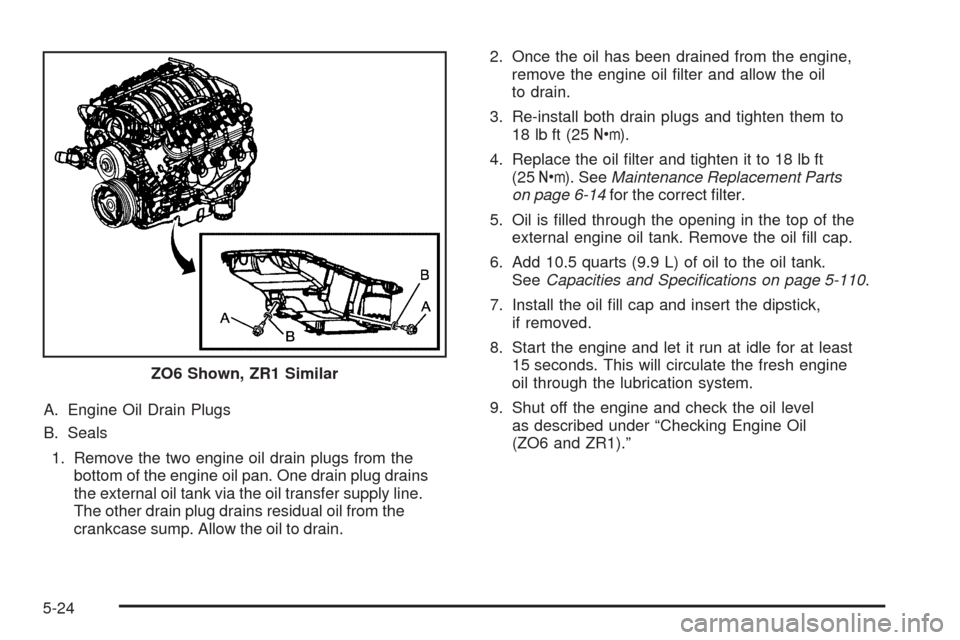
A. Engine Oil Drain Plugs
B. Seals
1. Remove the two engine oil drain plugs from the
bottom of the engine oil pan. One drain plug drains
the external oil tank via the oil transfer supply line.
The other drain plug drains residual oil from the
crankcase sump. Allow the oil to drain.2. Once the oil has been drained from the engine,
remove the engine oil �lter and allow the oil
to drain.
3. Re-install both drain plugs and tighten them to
18 lb ft (25Y).
4. Replace the oil �lter and tighten it to 18 lb ft
(25Y). SeeMaintenance Replacement Parts
on page 6-14for the correct �lter.
5. Oil is �lled through the opening in the top of the
external engine oil tank. Remove the oil �ll cap.
6. Add 10.5 quarts (9.9 L) of oil to the oil tank.
SeeCapacities and Specifications on page 5-110.
7. Install the oil �ll cap and insert the dipstick,
if removed.
8. Start the engine and let it run at idle for at least
15 seconds. This will circulate the fresh engine
oil through the lubrication system.
9. Shut off the engine and check the oil level
as described under “Checking Engine Oil
(ZO6 and ZR1).” ZO6 Shown, ZR1 Similar
5-24